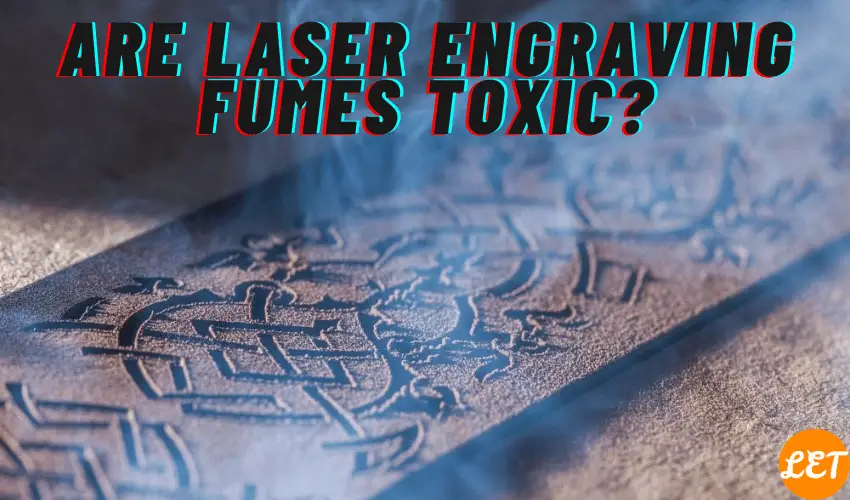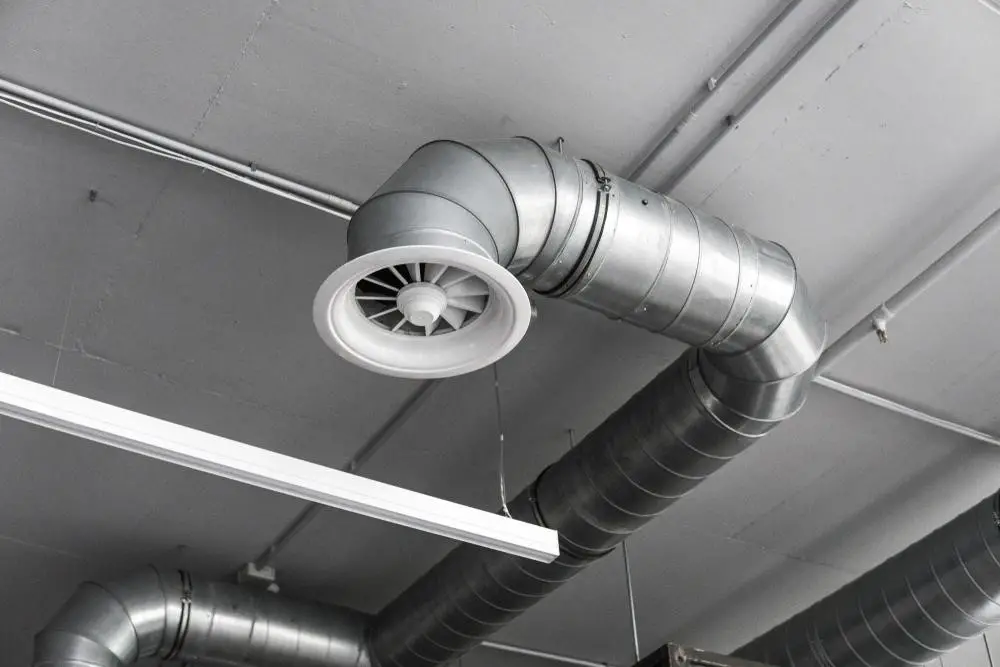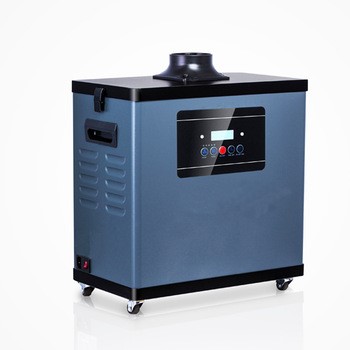Laser engraving is a great way to personalize property made from various materials, providing a permanent etch without any chance of the alterations wiping away. However, it does require vaporizing and removing particles, which end up in the air causing fumes. But are laser engraving fumes toxic?
Unfortunately, the answer is yes. Laser engraving fumes are toxic to humans and pets. The dangers of these fumes differ depending on the material you are working with. Nonetheless, using proper safety gear and air filtration is required during this activity.

Whether you are engraving for fun or a profession, knowing the ins and outs of laser engraving safety and how to protect yourself from toxic fumes are essential.
Table of Contents
Is Laser Engraving Safe?
If you do it properly, laser engraving is a safe activity to partake in and creates fabulous, artistic creations like nothing else. However, like most activities that require heat, lasers, or other methods of altering the composition of a material, laser engraving will create toxic fumes that are not safe to breathe in.
Most laser cutters do not have air filters, and therefore cannot eliminate the hazardous fumes created by the engraving process. This leaves the user and their machine vulnerable to severe dangers.
Health Hazards of Laser Engraving Fumes
As mentioned, fumes emitted through engraving wood, plastic, metals, and other materials will cause a chemical reaction that permeates the air and can cause mild to severe health conditions.
While many people will go their entire careers never experiencing any health issues from laser engraving, many will end up suffering some side effects if the proper precautions are not taken.
Skin and Eye Irritation
These toxic chemicals are known for irritating, sometimes seriously, your skin, eyes, mouth, and nose. This can be a mild case of itchy skin or red eyes. Or more severe symptoms such as painful rashes and difficulty breathing.
Some toxic fumes have contributed to blindness and severe burns.
Flu-Like Symptoms (Mostly Linked to Zinc)
Metal fume fever, typically connected to chemicals released when laser engraving zinc, can cause flu-like symptoms for anyone that breathes these fumes in. Symptoms of this condition include:
- Fever
- Chills
- Coughing
- Body aches
- Fatigue
- Sneezing
- Sore throat
Exposure to Cancer-Causing Carcinogens
Depending on the materials you are cutting, you risk the chance of releasing cancer-causing carcinogens into the air, which you will breathe in without the proper equipment.
No fumes are safe in this aspect. However, a few can be directly linked to cancer, according to research.
Some types of treated wood, metals, and plastics are directly related to cancer and other severe and fatal illnesses when exposed to or inhaled for prolonged periods.
VOCs | Health Concerns | Found in: |
Chlorine gas | Cancer Neurological damage Immune system damage Reproductive system damage | Plastic products PVC |
Benzine | Anemia Death Low white blood cells Cancer | Rubber |
Formaldehyde | Asthma attacks Cancer Allergies | Plastic Resins in wood Paints and coating on wood Lacquers and finishes |
Polyethylene | Cancer Asthma attacks Allergies | Plastic products |
Phosgene (Hydrochloric Acid) | Destroys lung tissue Cancer | Steel |
Chromium | Cancer Pulmonary sensitization Respiratory tract complications | Stainless steel |
Nickel | Lung cancer Fibrosis | Stainless steel |
Cobalt | Cancer Scarring of the lungs Heart, liver, thyroid, and kidney issues Asthma attacks | Tools Steel |
Cresol | Possible carcinogen Skin, eye, and mouth irritation Anemia Heart, liver, and lung damage Coma Facial paralysis | Wood |
Before engraving any material, make sure you know exactly what it is made up of and take all safety precautions possible.
Note: Most products are not lethal from short-term exposure, with the most notable complications being skin, eye, and mouth irritation. Other common health concerns include nausea, vomiting, coughing, wheezing, and feeling faint.
Chemical Buildup in the Body
Over time, inhaling toxic fumes can lead to chemical buildup in the body. Some of these chemicals can result in deadly reactions or serious health conditions.
Metals containing lead can lead to lead poisoning, which can be lethal. Cadmium is another metal known for slowly accumulating in the body during frequent exposure and is linked to kidney problems.
What Materials Should You Never Use a Laser Engraver On?
While most materials can produce harmful fumes during the engraving process, there is a handful that you should never engrave, even with proper protection.
The reason behind the push to steer clear of these materials is not just for human safety but also for the safety of the engraving machine.
- Polyvinyl chloride (PVC): The toxic gas that emanates from PVC (chlorine) can destroy the control system of your machine and can corrode the metal.
- Coated carbon fibers (Carbon): This material and its fumes can catch fire easily.
- Fiberglass: Laser cutting on fiberglass will produce a thick, black substance and discoloration that is visible and hard to remove. Epoxy resin (fumes) is harmful to the machine parts.
- ABS: Easily melts, leaving a sticky, hard-to-clean residue that can damage parts of your machine.
- Vinyl: Vinyl and polyvinyl omit chlorine gas which can damage your machine.
- Polystyrene foam: This material contributes to laser engraving fires.
The best way to stay safe when using a laser engraver is to read the manual and instructions to ensure you are always using it properly. You must also check these resources for specific materials you can and can not engrave.
Caution: Many materials are highly flammable. You should, therefore, keep a close eye during the cutting process to avoid accidents. Always a good idea to keep a fire extinguisher handy for any sudden flare ups. We use the First Alert Professional Fire Extinguisher in our workshop. More information can be found here.
Best Materials for Laser Engraving

Now that you know what not to cut with a laser engraving machine, here are a few examples of materials ideal for laser cutting and etching.
- Various woods: Refrain from resinous or oily wood.
- Plywood: The glue used to create this material makes it a little harder to cut.
- Cardstock: Easy and safe.
- Cardboard: Use caution as it may catch on fire.
- Cork: Keep the cork material thin for an easier cut.
- Leather: Never use fake imitation leather.
- Glass: Flat glass or cylinders with a rotary device
- Ceramic: Easy to work with
- Marble, granite, and stone: Provides a nice textured look.
These are only a handful of safe materials with a laser engraving machine that emits fumes that won’t cause significant health issues.
For detailed information on the best materials for laser engraving along with product recommendations then check out this article I wrote on the subject.
With that said, no matter what material you use doesn’t mean you shouldn’t have an air filtration system always running when engraving. The best air to breathe is clean, filtered air without particles or residue.
Ways to Protect Yourself from Laser Engraver Fumes

Just because engraving certain materials can be toxic doesn’t mean you should be too afraid to do it. Learning the best ways to protect yourself from these hazardous fumes will give you peace of mind while designing.
- Safety Glasses: Safety glasses are vital when using a laser engraver. Aside from keeping your eyes safe from the laser itself, it will help protect you from eye damage from the fumes. For detailed information then please read this article I wrote on laser engraving eye protection.
- Gloves and Tight-Fitting Clothes: Some fumes can cause skin irritation and even burns. When working, ensure you have a quality pair of gloves and non-flammable long sleeves.
- Face Mask or Covering: Some people wear a face mask or cover when working with a laser engraver to protect themselves from air pollution.
- Fume Exhaust System: Even if you choose to wear a mask, it is essential to have a fully functioning exhaust system installed when working with a laser engraver.
These are some of the best ways to ensure your safety from fumes when working with a laser engraving machine. However, there are other precautions you should take due to the dangers of the machine itself.
- Always keep complete control of the laser.
- Never try to lift or move the machine alone.
- Wear non-flammable clothing to reduce the chances of catching fire.
- Keep the machine in a safe, clean location.
- Never leave the machine running when no one is around.
While laser engraving is a fun and profitable activity, it can also be dangerous in many ways if not done correctly.
To improve the ventilation in your workspace it would be advisable to install a suitable exhaust fan. On the below link you will find more information on the top 5 laser engraver exhaust fan options.
Ways to Protect Your Machine from Laser Engraving Fumes
Your engraving machine cannot wear eye goggles or gloves to keep itself safe from the toxic fumes that can cause significant damage. However, you can do your due diligence to keep these vapors from destroying it or wearing it down.
When your engraving machine is exposed to toxic gasses for long periods, it can affect its performance which can, in turn, negatively impact each project you work on.
- Clean the Air Nozzle: The air nozzle can get clogged with debris. Clear the air nozzle with tweezers or a toothpick, and use the tools provided to wipe it down.
- Clean the Laser Head: You also want to use the provided materials and a little rubbing alcohol to clean off and wipe down the laser head.
- Wipe down the mirrors: Fumes can create a film of chemicals on the lenses and mirrors of an engraver. Wiping them down frequently can help limit the amount of damage it causes.
- Use Proper Fume Extraction Equipment: Removing the fumes from the air as quickly as possible is the best way to keep your machine in optimal working condition. You can also use a laser engraver enclosure. More information can be found in the article that I wrote here.
The best way to maintain your laser engraving machine is by taking the time to read through the manual thoroughly. Each machine is different and requires its own maintenance and upkeep routines.
Should You Use a Laser Engraving Machine Indoors?

It is typically recommended that anyone using a laser engraver at home do so in a garage, barn, or other outdoor building where ventilation to the outside is easiest.
Along with hazardous fumes, the smell that comes from engraving certain materials can definitely be a cause for concern when using these machines inside the home.
No matter where you set up shop, installing a fume extractor and filtration system is imperative to keep things safe.
Bringing these systems into your home isn’t always ideal, but with the right machine, it isn’t impossible.
One issue some people run into is how loud some of these machines can get. If you don’t have a quality fume extractor with a noise level under 60 dB, you will probably regret bringing it inside.
Important Buying Guides: Laser Engraver Exhaust Fan Options Laser Engraver Enclosure Options Fume Extractors For Laser Engravers
What Are Fume Extractors?

A fume extractor is an air-purifying system that removes fumes, residue particles, and toxins in the room before they have time to harm you or your engraving machine.
There are numerous systems on the market, each offering the ability to extract fumes from various particles depending on what materials you work with.
A fume extraction fan will create a strong suction to pull the poisonous gasses into the machine, then utilizes filters that capture them, purifying the air and allowing you to dispose of the dangers.
For detailed information on the best fume extractors for laser cutters & engravers then have a look at our buying guide here.
Are Air Purifiers Adequate for Extracting Laser Engraving Fumes?
Not all air purifiers are strong enough or equipped with the proper filters to remove all the toxic particles from the air. However, a few out there offer the ability to clean the air after laser engraving.
Adequate air purifiers should be industrial-grade with at least three layers of air filtration. Along with hazardous fumes, laser engraving also leaves large and microscopic particles lingering in the air that need to be removed.
With that said, your basic home air purifier is likely incapable of keeping your space safe from harmful fumes.
Using a Fume Extractor
The best way to keep yourself, other workers, and your equipment safe from laser engraving fumes is by keeping the fume extractor as close to the source as possible.
Keeping the particles from moving too far from the work area is the easiest way to ensure safety and quality air control.
Getting a fume extractor comparable in size to the space you work in is also essential. Industrial-sized purifiers are recommended for larger areas and multiple machines.
Final Thoughts
While laser engraving fumes are often toxic and can be very dangerous to breathe in, there are precautions you can take to ensure the safety of yourself and others around you.
The best way to enjoy your laser engraver while maintaining peace of mind is to know which materials are safe and which ones you should steer clear of.
